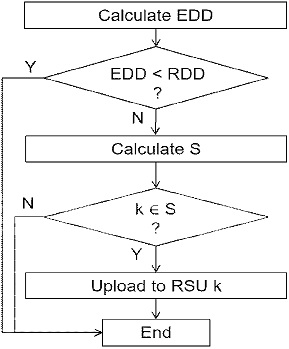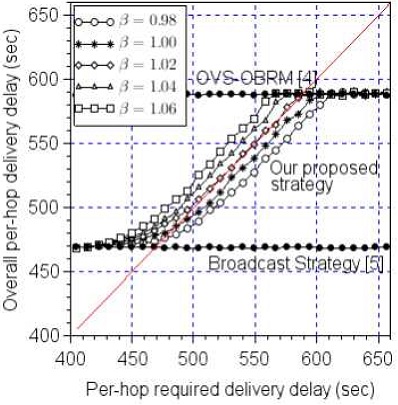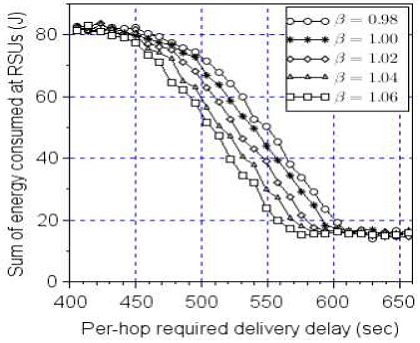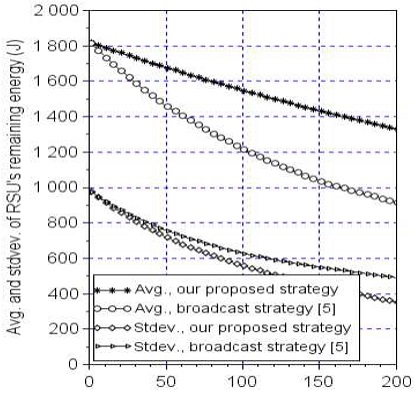
Energy-Efficient Data Delivery Strategy for V2I Systems with Power-Constrained Road Side Units
Abstract
Because some vehicular ad hoc networks (VANETs) are expected to operate with self-powered elements, the communication among the network entities should be made in an energy-efficient way. In this paper, we propose a new data delivery strategy for V2I (vehicle-to-infrastructure) systems with road side units (RSUs) with a constrained power source. According to our proposed strategy, the data-carrying vehicle node determines if the visited RSU should participate in the data delivery procedure according to the respective transmission distances of RSUs along the delivery path and the value of the required delivery delay. Numerical analysis shows that our proposed strategy results in timely data delivery over a specific range of required delay values while efficiently consuming the energy of the RSUs, resulting in better performances compared to the previous strategies.
초록
일부 차량 기반 애드혹 네트워크(VANET)는 자체적인 전원을 이용하여 동작하기 때문에 네트워크 장치 간의 통신은 효율적인 에너지 사용 기반에 의하여 이루어져야 한다. 본 논문에서는 제한된 전원으로 동작하는 RSU을 보유한 V2I 시스템을 위한 효과적인 데이터 전달 기법을 제안한다. 제안하는 기법에 따르면, 데이터를 가지는 차량 노드는 데이터 전달 경로상의 RSU들의 각각의 전송 거리와 전달 지연 요구값에 기반하여 방문하는 RSU가 데이터 전달 과정에 참여하는지를 결정한다. 수치적 분석을 통하여 제안하는 방법은 RSU에서의 효과적으로 에너지를 소비하면서 전달 지연 요구값의 특정 영역에서 적정한 데이터 전달 시간을 가지며, 결과적으로 기존의 방법들에 비하여 향상된 성능 지표를 가짐을 확인하였다.
Keywords:
V2I system, ernery-constrained road side unit, data delivery delay, variable transmission distanceⅠ. Introduction
The VANET (vehicular ad hoc network) provides communication among network entities such as moving vehicle nodes and fixed road side units (RSUs). It enables the implementation of various kinds of services and applications related to intelligent transportation systems[1]-[5]. Unlike the typical wireless ad hoc networks, the VANET has unique characteristic: It is formed as lines along the roads or as grids over the streets. Moreover, the network has both vehicle nodes with high mobility and stationary infrastructure entities over a wide area[1]. These aspects need to be considered when VANETs and their applications are designed and implemented.
Because many of the VANET applications are based on exchanges of the real-time information, it is important to deliver data to the destination within the required time limit, also called data delivery delay[4]-[6]. Specifically when the network has RSUs with power-constrained power sources, their energy consumption needs to be considered in the data delivery procedure[6]-[8].
Unlike the V2V (vehicle-to-vehicle) system where direct communication among vehicle nodes is possible, vehicle nodes of the V2I (vehicle-to-infrastructure) system can communicate only with the RSUs and inter-vehicle communication is not feasible[5]. Therefore, the data exchange among RSUs of V2I systems is done with the aid of moving vehicle nodes as data carriers because of the unavailability of direct communication among RSUs[4][5].
One of the simplest approaches to reducing the data delivery delay between RSUs is increasing the RSUs' wireless transmission distances. However, this is not an appropriate solution because it would decrease the transmission rate and increase the packet collision rate[9].
Moreover this would also increase the energy consumption at the RSUs, possibly resulting in energy depletion at the energy-poor RSUs. Therefore, data deliveries among power-constrained RSUs should be made with consideration given to both the data delivery delay and RSUs' efficient energy usage[8][10].
In this paper, we propose a new strategy for data exchange among RSUs to provide the best-effort timely delivery with efficient energy consumption at RSUs. We accomplished this by selecting the minimum number of RSUs with a relatively high remaining energy for participation in the data delivery procedure and by having other RSUs exempt from energy consumption. The algorithm to determine whether an RSU should participate in the data delivery is based on the values of the expected delivery delay, the required delivery delay, and the transmission distances of RSUs on the data path.
Following this section, we present the related works in section 2, and our proposed strategy in section 3. Then, section 4 contains numerical analysis of the performance measures of our proposed strategy and a comparison with the previous strategies, Finally, we conclude the paper in section 5.
II. Related Works
Most of the previous data delivery strategies for VANET systems have focused on reducing data delivery time[3]-[5][9]. The optimal vehicle selection-opportunistic bundle release mechanism (OVS-OBRM) [4] proposed a data delivery strategy between two RSUs for V2I systems. This strategy proposed that a source RSU should select a single vehicle node with the fastest estimated arrival time at the destination RSU. However, this approach did not consider the general case of the V2I systems with multiple RSUs between the source and the destination of the data. Later, a broadcast-based data delivery strategy[5] was proposed for the V2I systems with multiple RSUs.
The above data delivery strategies have a distinct difference in that the OVS-OBRM[4] uses a single vehicle node without participation of RSUs between the source and the destination and the broadcast strategy[5] uses multiple vehicles with participation of all RSUs between the source and the destination. Therefore it is obvious that the delivery time of the OVS-OBRM[4] was significantly longer than that of the broadcast strategy[5].
Because exchanging data among network entities is one of the most important and the most frequent operations in a VANET system, the energy consumption as well as the delivery delay should be considered when their data delivery strategy is designed, especially for the VANETs with power-constrained entities[8][10].
A recent study considered both the packet delay and the harvested energy at the same time for wireless ad hoc networks[6]. They considered the multi-hop wireless network in which a communication node can harvest energy through part of the received signal. However, it is difficult to apply that approach to the V2I systems because generally in V2I systems the configuration of the power-sufficient vehicle nodes changes very rapidly and a direct communication link between RSUs cannot be made.
Another study proposed scheduling algorithms for a down-link connection from energy-harvesting RSUs to multiple vehicle nodes for VANETs[7]. Based on the RSU's available energy and the communication cost to each vehicle node, these approaches improve the performance measures such as the number of vehicle nodes served and the service delay with respect to the number of RSUs and the vehicle density. However, that study did not consider the delay for data delivery between RSUs with multiple hops between them.
Meanwhile, if we analyze the V2I-based data delivery strategies of [4] and [5] from the point of view of both energy consumption and data delivery delay, it is clear that they have the opposite characteristics as follows. The OVS-OBRM[4] may have the least energy consumption at the source and destination RSUs only but it might not satisfy the requirement of data delivery delay. In contrast, the broadcast strategy[5] may extravagantly consume energy at all or some of the RSUs between the source and destination while overly satisfying the delay requirement.
III. Proposed strategy
3.1 System structure
In this paper, we consider a V2I system with RSUs sparsely deployed along the roadside. RSUs are equipped with a power-constrained power source such as energy harvesting modules. Because the distance between two neighboring RSUs is larger than their transmission distances, they exchange data with the aid of passing vehicle nodes as data carrying media.
For the efficient use of the constrained energy, we assume that each RSU adjusts its own transmission distance according to its remaining energy in a way that the RSU with the higher remaining energy has the larger transmission distance. RSUs exchange the latest information about the transmission distances of other RSUs, and when necessary the passing vehicle nodes may also acquire this information from the RSU's periodic broadcast message.
3.2 Data delivery strategy
When a source RSU has data to send, it transmits data directly to a specific vehicle node within its transmission coverage. If there is more than one vehicle node within the source RSU's coverage, the source RSU chooses one of vehicle nodes within its transmission coverage which is moving forward and closest to the destination RSU. Then the chosen vehicle node becomes a data carrier and carries data until it uploads data to other RSU on the data delivery path.
Afterwards, when a data-carrying vehicle node recognizes that it enters the transmission coverage of the neighboring RSU (for example, by a vehicle node's continuous transmission of the short signaling messages and its response from an RSU), it determines whether or not to upload data to the visited RSU, according to the algorithm that is described in the following section.
If a data-carrying vehicle node decides that it uploads data to the newly visited RSU and accordingly makes it participate in data delivery, it immediately executes data uploading to the visited RSU. Then the RSU transmits the data to one of the vehicle nodes within its transmission coverage in the same way that the source RSU executes
On the other hand, if a data-carrying vehicle node determines to not upload data to the newly visited RSU, it keeps the data without any further action regarding the data delivery. The determination of a visited RSU's participation and the consequent data forwarding repeat until the data arrives at the destination RSU.
We can expect that whether an RSU participates in data delivery influences the overall data delivery delay and the energy consumption at RSUs. In the following section we introduce an algorithm to determine whether the visited RSU should participate in data forwarding to satisfy both the timely data delivery and the RSU's efficient energy usage.
3.3 Determination of RSU's participation
If all RSUs between the source and destination RSUs participate in data delivery, the overall data delivery time from the source RSU to the destination RSU can be minimized. However, this approach requires the energy consumption at every RSU, possibly making the energy-poor RSUs deplete their energy and finally stop working. When the data-carrying vehicle node enters the transmission coverage of an RSU, it calculates the expected delivery delay (EDD).
If the EDD is smaller than the required delivery delay (RDD), the RSU's participation in data delivery may overly meet the RDD requirement. Even when the EDD is larger than the RDD, there is a chance that the participation of a limited number of RSUs on the data path with the relatively high remaining energy would satisfy the RDD requirement. From this respect, we propose the criteria to determine if the visited RSU should participate in data delivery to satisfy the timely data delivery.
When a data-carrying vehicle node enters an RSU's coverage, it determines whether or not to upload data to the visited RSU according to the flowchart depicted in Fig. 1. First, the data-carrying vehicle node calculates the EDD which is the overall data delivery delay from the time of data occurrence at source RSU to the time of its arrival at the destination RSU under the assumption that the data-carrying vehicle node maintains its current speed and keeps data until it reaches the destination RSU's coverage. If the EDD is less than the RDD (which is set at the source RSU and specified in the header field of the data), the data-carrying vehicle node determines that the visited RSU should not participate in data delivery.
We can expect that participation of the RSUs with longer transmission distance would contribute more to reducing the overall data delivery delay than choosing ones with shorter transmission distance. Therefore, if the EDD is longer than the RDD, the data-carrying vehicle node calculates S, a set which includes the minimum number of RSUs whose participation satisfies the RDD requirement.
If the currently visited RSU is one of the elements of S, the data-carrying vehicle node executes data uploading to the currently visited RSU and the latter consequently participates in data delivery by forwarding the received data to one of the vehicle nodes within its transmission coverage. On other hand, if the currently visited RSU is not an element of S, the data-carrying vehicle node keeps the data without uploading it, which makes the currently visited RSU exempt from the data delivery procedure.
According to our proposed strategy, when a data-carrying vehicle node enters the transmission coverage of the RSU k at the time t with the speed v, it calculates the EDD, denoted by DE(k,t) under the assumption that it keeps data at the current speed until it reaches the coverage of the destination RSU N. Therefore, DE(k,t) can be written as Eq. (1).
| (1) |
Then, the data-carrying vehicle node compares DE(k,t) and the value of RDD (denoted as DR). If DE(k,t) ≤ DR, then the data-carrying vehicle node does not upload data to the RSU k and the RSU k becomes exempt from data delivery. Otherwise, if DE(k,t) > DR, the data-carrying vehicle node should achieve S from the following procedure.
Firstly, it achieves u(i), the sorted identification numbers of the RSUs between k and N-1 (inclusive) such that the identification number of the RSU with larger transmission distance comes before ones with lower transmission distances. Then, with denoting the transmission distance of RSU i as C(i), we have u(i) = 1,2,3 ..., N-k, satisfying C(u(i) ≥ C(u(i+1), for any i, 1 ≤ i ≤ N-k-1. Then, based on u(i), the set S can be achieved according to Eq. (2).
| (2) |
where,
| (3) |
We introduce the correctional coefficient β in Eq. (3) to reflect a realistic aspect, that is, the next data-carrying vehicle node is located normally within the transmission coverage of the visited RSU, rather than exactly on its transmission boundary at the moment of the RSU's data forwarding.
Finally, for the data-carrying vehicle node entering the RSU k, if k∈S, then it determines that the RSU k should participate in data delivery. Otherwise, if k∉S, the data-carrying vehicle node keeps the data without uploading. We note that there exists a case in which it would still be impossible to satisfy the RDD requirement even if all the RSUs between the source and destination participate in data forwarding. This is generally due to the innate system limitations such as an inappropriately small value of the RDD, the very low vehicular traffic density, or the very low speed of vehicle nodes possibly due to the excessively high vehicular traffic density.
Ⅳ. Performance Evaluation
For the numerical analysis and the evaluation of our proposed strategy, we introduce the following performance measures, the average per-hop delivery delay, the average number of the participating RSUs, and the energy consumed at the RSUs for communication. We assume the V2I system with 10 RSUs (N = 10) on a straight road with the inter-RSU distance of 2,000 meters. To represent the temporal movements of vehicle nodes, we use the vehicular traffic model for the vehicle nodes' occurrences, positions, speeds, and lane changes from the SUMO (Simulation of Urban MObility) simulator[11].
Based on the experimental results in [12], we assume a three-lane unidirectional road where the vehicle's maximum speed is 35 m/s, the driver's imperfection factor is 0.5, and both acceleration and deceleration rates are 0.6 m/s2 for our simulation environment. We also assume that the transmission distance of an RSU is proportional to the square root of its randomly assigned remaining energy, and it is limited between 40 and 400 meters. We also assume that the size of each data is b = 1.25 Mbytes.
We achieved the average values of performance measures from one hundred data deliveries. For the comparison of the performance measures with those of the previous strategies, we also executed a numerical analysis for the data delivery strategies of the OVS-OBRM[4] and the broadcast strategy[5] under the same conditions.
4.1 Data delivery delay
For simplicity, we have the per-hop delay time from dividing the value of the delay time by the number of hops between the source RSU and the destination RSU (which is 9 for our analysis). Fig. 2 shows the change of the average per-hop delivery delay as the per-hop RDD (mathematically denoted as DRp varies, for the different vehicular traffic density of 2,000 vehicles/hour.
We add a straight line of an equation in a form of y = x in the figure to show the reference for the ideal case where the actual delivery delay is exactly the same as the RDD. The result in the region of y > x signifies that the actual data delivery delay cannot satisfy the RDD requirement, and the result in the region of y < x signifies that the actual delivery delay overly satisfies the RDD requirement. From Fig. 2, it is evident that the OVS-OBRM[4] and the broadcast strategy[5] have their own constant delay values regardless of the RDD.
As for our proposed strategy, we see that the data delivery delay lies between that of the OVS-OBRM[4] and that of the broadcast strategy[5]. We also see that as the value of β decreases the delivery delay of our proposed strategy decreases. This is because the smaller values of β reduce the value of the right term of Eq. (3), which results in a more strict condition for determining the RSU's participation.
Therefore, having the smaller values of β seems to be advantageous in respect of the data delivery delay. However, this may increase the number of the participating RSUs while overly satisfying the RDD requirement. Accordingly, we see that the optimal value of β can be achieved when the RDD value is set within a specific region, so that the data delivery time is almost the same as the RDD value.
4.2 Energy consumption at RSUs
In this section, we analyze the energy consumption at RSUs for data delivery under our proposed strategy and the previous broadcast strategy[5]. We use the free-space energy-consumption model from an earlier study[13], in which ET(b,x) and ER(b) represent the energy consumption, respectively to transmit and to receive a b-bit packet at a distance of x meters. Therefore, according to our proposed data delivery strategy, when a data-carrying vehicle node enters an RSU k at time t, the energy consumed by the RSU k is represented as Eq. (4).
| (4) |
With the same parameters used above, we achieved the sum of energy consumed by all RSUs for a single data delivery with respect to the per-hop RDD, shown in Fig. 3. We see that the total energy consumption decrease as the RDD increases. This is because the higher value of the RDD necessitates fewer participating RSUs to satisfy the RDD requirement, which results in less total energy consumption.
Therefore, the change in energy consumption with respect to the RDD is similar to that of the number of the participating RSUs shown in Fig. 2.
4.3 Temporal change in RSUs' energy
In this section, we analyze the temporal change in the remaining energy of all RSUs over the consecutive data deliveries. The results were achieved for the first 200 consecutive data deliveries from the initial status, with DRp = 500 seconds and a vehicular traffic density of 2,000 vehicles/hour.
We assume that as soon as a data delivery is completed at the destination RSU, new data occurs at the source RSU and the transmission distance of each RSU is readjusted proportional to the square root of its updated remaining energy. The value of β is also accordingly set so as to have a timely data delivery at the destination. For simplicity, the RSUs are assumed to not have a recharging process.
Fig. 4 shows the temporal change in the average and the standard deviation of the remaining energy of 10 RSUs for the 200 consecutive data deliveries. We see that our proposed strategy maintains a higher average energy than the broadcast strategy[5], and the decreasing slope of our proposed strategy (approximately -2.40 J/round) is less than that of the broadcast strategy (approximately –4.43 J/round).
As for the change in standard deviation of the RSUs' remaining energy, it decreases as more data deliveries are completed. This is because the participating RSUs consume their energy for data delivery which is proportional to their own remaining energy. In addition, the energy consumption of our proposed strategy is made at a number of RSUs with relatively large remaining energy while the other energy-poor RSUs are exempt from consuming energy. Therefore, the standard deviation of the remaining energy under our proposed strategy decreases more significantly than that of the broadcast strategy[5].
V. Conclusion
As some VANET systems are expected to have power-constrained RSUs for self-sustainability, we proposed a new data delivery strategy for V2I systems in which RSUs can exchange data with the help of the passing vehicle nodes.
According to our proposed strategy, when a data-carrying vehicle node enters the area of an RSU's transmission coverage, it determines if the visited RSU participates in data delivery procedure. This decision is made according to the criteria of the required delivery delay and the remaining energy of the RSUs.
The numerical performance analysis showed that the data delivery delay of our proposed strategy lies between that of the strategy that uses a single optimal vehicle as the data carrier and that of the broadcast strategy where all RSUs participate in data delivery. In addition, we confirmed that our proposed strategy is more advantageous for energy consumption and the energy balance among RSUs over time, compared to the previous data delivery strategies.
Acknowledgments
이 논문은 공주대학교 연구년 사업(2016)에 의하여 연구되었음
References
-
M. N. Tahir, M. Katz, and U. Rashid, "Analysis of VANET Wireless Networking Technologies in Realistic Environments", Proceedings of 2021 IEEE Radio and Wireless Symposium (RWS), San Diego, CA, USA, pp. 17-22, Jan. 2021.
[https://doi.org/10.1109/RWS50353.2021.9360381]

-
B. Suh, "Variable transmission distance-based data delivery strategy to support near-optimal delivery delay for V2I systems", The Journal of Korean Institute of Information Technology, Vol. 17, No. 12, pp.93-100, Dec. 2019.
[https://doi.org/10.14801/jkiit.2019.17.12.93]

-
S.-G. Kim, "Routing Protocols for Enhancing the Packet Delivery Ratio in VANET", The Journal of Korean Institute of Information Technology, Vol. 19, No. 7, pp.73-79, Feb, 2021.
[https://doi.org/10.14801/jkiit.2021.19.2.73]

-
M. J. Khabbaz, W. F. Fawaz, and C. M. Assi, "Which vehicle to select?", IEEE Commun. Lett., Vol. 16, No. 6, pp. 812-815, Jun. 2012.
[https://doi.org/10.1109/LCOMM.2012.042512.112350]

-
B. Suh and S. Berber, "Broadcast-based data delivery strategy for V2I multihop vehicular networks", IET Elect. Lett., Vol. 50, No. 7, pp. 556-558, Mar. 2014
[https://doi.org/10.1049/el.2013.4205]

-
J.-S. Liu, C.-H. Richard, and J. Tsai, "Delay and energy tradeoff in energy harvesting multi-hop wireless networks with inter-session network coding and successive interference cancellation", IEEE Access, Vol. 5, pp. 544–564, Dec. 2017.
[https://doi.org/10.1109/ACCESS.2016.2645704]

-
W. S. Atoui, W. Ajib, and M. Boukadoum, "Offline and online scheduling algorithms for energy harvesting RSUs in VANETs", IEEE Trans. Vehic. Tech., Vol. 67, No. 7, pp. 6370-6382, Jul. 2018.
[https://doi.org/10.1109/TVT.2018.2797002]

-
R. Atallah, M. Khabbaz, and C. Assi, "Energy harvesting in vehicular networks: A contemporary survey", IEEE Wireless Commun., Vol. 23, No. 2, pp. 70–77, Apr. 2016.
[https://doi.org/10.1109/MWC.2016.7462487]

-
C. Guo, D. Li, G. Zhang, and Z. Cui, "Data delivery delay reduction for VANETs on bi-directional roadway", IEEE Access, Vol. 4. pp. 8514-8524, Dec. 2016.
[https://doi.org/10.1109/ACCESS.2016.2640193]

-
Q. Ibrahim, "Design, implementation and optimisation of an energy harvesting system for ad hoc networks’ road side units", IET Intell. Transp. Syst., Vol. 8, No. 3, pp. 298–307, May 2014.
[https://doi.org/10.1049/iet-its.2012.0206]

- SUMO - Simulation of Urban MObility, available at http://sumo.dlr.de, ,[Accessed: May 1, 2021]
- A. Mehar, S. Chandra, and S. Velmurugan, "Speed and acceleration characteristics of different types of vehicles on multi-lane highways", European Transport, Vol. 55, No. 1, pp. 1-12, Jan. 2013.
-
W. B. Heinzelman, A. P. Chandrakasan, and H. Balakrishnan, "An application-specific protocol architecture for wireless microsensor networks", IEEE Trans. Wireless Commun., Vol. 1, No 4, pp. 660-670, Oct. 2002.
[https://doi.org/10.1109/TWC.2002.804190]


Feb. 1993 : Dept. of Electronics Engineering (BSE)
Feb. 1995 : Dept. of Electrical Engineering, KAIST (MSE)
Aug. 1999 : Dept. of Electrical Engineering, KAIST (Ph.D)
July 1999 ~ Feb. 2004 : Senior Researcher, ETRI (Electronics and Telecommunications Research Institute)
Sep. 2005 ~ Current : Professor, Kongju National University
Research interest : Computer Networks, Wireless Mobile Networks




